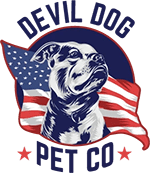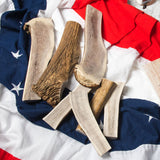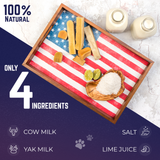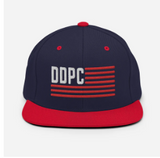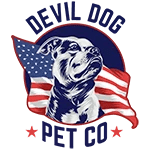Dog dental chews that actually clean teeth combine mechanical scraping action with the right texture and staying power—not the grocery store gimmicks collecting dust in your pantry. The best dental chews physically scrape plaque while your dog works the surface, stimulate saliva production to neutralize acids, and last long enough to make a difference.
After testing hundreds of options with our dog Dexter and working with thousands of customers, we've identified eight proven contenders that deliver results you can actually see.
Key Takeaways
- Effective dog dental chews combine mechanical scraping with the right texture and durability.
- The best chews physically remove plaque and stimulate saliva to neutralize acids.
- Many grocery store dental chews are ineffective and often go unused.
- Testing and customer feedback helped identify eight dental chews that provide visible results.
Table of Contents
- The Truth About Dog Dental Chews: What Actually Works
- The 3 Categories of Dog Dental Chews That Matter
- What Makes a Dental Chew Actually Work?
- The 8 Best Dog Dental Chews That Actually Work
- How to Maximize Dental Benefits from Chews
- Dental Chews for Every Dog: Finding the Perfect Match
- Real-World Results: What Actually Works
- The Bottom Line on Dental Chews
Let's face it—most dogs hate toothbrushes, and most owners hate wrestling with them. That two-minute dental standoff becomes a twice-yearly guilt trip instead of a daily habit. No judgment here. The statistics tell the story: over 80% of dogs show signs of dental disease by age three, yet fewer than 2% of owners brush their dog's teeth daily. Learn more about these statistics and dental care tips on WebMD.
This gap between what should happen and reality is where quality dental chews earn their keep. They're not a complete replacement for brushing, but they're the reinforcements your dog's mouth desperately needs.
Why Oral Health Matters For Your Dog's Overall Wellbeing
Bad breath isn't just an inconvenience—it's a warning. When plaque hardens into tartar, the real trouble begins. Bacteria multiply below the gumline, creating inflammation that destroys tissue and bone. This isn't just about teeth; it's about your dog's entire system.
The bacteria from infected gums don't stay put. They travel through the bloodstream and can damage vital organs including:
- Heart valves (bacterial endocarditis)
- Kidneys (increased risk of kidney disease)
- Liver (elevated enzymes and inflammation)
Veterinary dentists report that proper dental care can add 2-5 years to your dog's life. That's not marketing hype—that's the difference between dropping your dog at the rainbow bridge at 10 versus 15 years old. See Whole Dog Journal's deep dive into dental chews for more details.
What Are Dog Dental Chews (And What Are They Not)?
Dental chews for dogs are specialized treats designed to clean teeth through mechanical action as your dog gnaws. The best ones have textured surfaces that scrape plaque, stimulate gums, and freshen breath. Some include enzymes that break down bacteria or ingredients that reduce tartar formation.
But let's be crystal clear about what they're not:
- They're not magic erasers that fix existing tartar buildup
- They're not substitutes for professional dental cleanings
- They're not all created equal—most pet store varieties are glorified dog cookies
The dental sticks and bones that actually work share key characteristics: appropriate hardness, the right texture for scraping, and staying power that keeps your dog engaged long enough to make a difference.
The 3 Categories of Dog Dental Chews That Matter

After testing hundreds of products, we've found dental chews fall into three main categories, each with distinct advantages:
Natural Dental Chews: The Gold Standard
Natural dental chews include single-ingredient options like antlers, bully sticks, and Himalayan yak cheese chews. These all-natural dental chews deliver superior dental benefits because they're dense enough to resist immediate consumption but yielding enough to create abrasive action against teeth.
The standouts in this category:
- Split Elk Antlers: Expose marrow for flavor while providing a firm surface that scrapes plaque without excessive hardness. A Medium split antler typically lasts 2-3 weeks for a 40-pound dog.
- Himalayan Yak Cheese: Hard-pressed cheese that softens slightly during chewing, conforming to tooth surfaces and removing plaque while dogs work the lactose-free treat.
- Bully Sticks: Single-ingredient beef muscle that creates fibrous strands as dogs chew, acting like natural floss between teeth.
These natural dental chews work because they require sustained effort. The longer your dog chews, the more mechanical cleaning occurs. When Dexter gnaws his split antler, we can literally see the white plaque being scraped away from his back molars—the hardest area to reach with a toothbrush.
Enzymatic Dental Chews: The Science Approach
These dental sticks for dogs contain added enzymes that break down plaque biofilm chemically, supplementing the mechanical action. The enzyme dextranase targets the sticky substance that helps plaque adhere to teeth, while glucose oxidase creates hydrogen peroxide to kill bacteria. See research on the effect of dental products and natural chews on oral bacteria.
Notable options include:
- Veterinary-Formulated Dental Sticks: Often containing chlorhexidine or other antimicrobials that reduce oral bacteria counts
- Enzyme-Coated Rawhide Alternatives: Digestible chews with enzyme systems that continue working after the chewing stops
The challenge with many enzymatic dental chews is longevity—most disappear too quickly to provide meaningful mechanical cleaning. The best versions balance palatability with staying power.
Textured Dental Treats: The Convenient Option
These dental bones for dogs feature ridges, nubs, or grooves designed to scrape teeth as dogs chew. They're typically softer and more rapidly consumed than natural options but offer convenience for busy households.
Examples include:
- Dental Chew Sticks: X-shaped or brush-shaped treats with ridges that clean as dogs bite down
- Dental Bones: Larger format treats with cleaning textures and longer-lasting formulations
The reality check: most textured treats disappear too quickly to provide significant dental benefit. A chew that's gone in 30 seconds can't clean effectively, regardless of its shape or marketing claims.
What Makes a Dental Chew Actually Work?
After years of testing with our own dogs and gathering feedback from thousands of customers, we've identified five non-negotiable factors that separate effective dental chews from pretenders:
1. The Chew-Time Factor
The single most important element is how long your dog actively works the chew. A dental chew needs to last at least 15-20 minutes to provide meaningful cleaning. Many popular dental sticks for dogs fail this basic test—they're gone in seconds, providing about as much dental benefit as a potato chip.
Our testing reveals the average chew times for different products:
- Grocery store dental treats: 30 seconds to 2 minutes
- Premium textured chews: 5-10 minutes
- Bully sticks: 20-40 minutes
- Himalayan yak chews: 30-60 minutes
- Split antlers: 30+ minutes per session over weeks
When Dexter gets his split antler, he settles in for a solid 30-minute gnawing session. The sustained chewing creates friction against his teeth, physically removing plaque that would otherwise harden into tartar.
2. Texture and Abrasiveness
Effective dental chews need the right balance of hardness—firm enough to scrape plaque but not so hard they risk tooth fracture. The texture should create friction against tooth surfaces without damaging enamel.
Our testing with different textures shows:
- Too soft (like many dental treats): Minimal cleaning effect
- Too hard (like weight-bearing bones): Risk of tooth fracture
- Just right (like split antlers, yak chews): Maximum plaque removal with minimal risk
3. Size and Shape Matter
The dental chew must be appropriately sized for your dog—large enough that they can't swallow it whole but shaped to allow access to back teeth where most dental disease begins.
Size guidelines we recommend:
- Small dogs (under 20 lbs): Minimum 4-5" length
- Medium dogs (20-50 lbs): Minimum 6" length
- Large dogs (50+ lbs): Minimum 8-12" length
Shape also impacts cleaning effectiveness. Curved or irregular surfaces often clean better than perfectly straight chews because they reach different parts of the mouth as the dog manipulates them.
4. Ingredients and Digestibility
What happens if your dog swallows pieces of the chew? Natural dental chews like bully sticks are fully digestible protein, while others like antlers are typically gnawed rather than consumed.
Always prioritize:
- Single-ingredient or minimal-ingredient chews
- No artificial colors, flavors, or preservatives
- Digestible components in case of swallowing
- Sourcing transparency
When reviewing ingredient lists, shorter is almost always better. Our Himalayan yak chews contain just four ingredients: yak milk, cow milk, salt, and lime juice. Nothing artificial, nothing questionable.
5. The Palatability Factor
Even the most effective dental chew is useless if your dog ignores it. The best dental sticks for dogs balance cleaning power with taste appeal.
In our testing, natural flavors consistently outperform artificial ones:
- Exposed marrow in split antlers provides natural flavor dogs crave
- The umami richness of yak cheese creates lasting appeal
- The meaty satisfaction of bully sticks drives engagement
When Dexter first encountered a split antler, he spent nearly an hour investigating and chewing—far longer than with any artificially flavored dental treat.
The 8 Best Dog Dental Chews That Actually Work

After extensive testing and customer feedback, these eight dental chews consistently deliver measurable improvements in canine oral health. Each offers unique benefits depending on your dog's chewing style, size, and preferences.
1. Split Elk Antlers
Split antlers expose nutrient-rich marrow while maintaining the dense outer wall that creates ideal scraping action. When our dog Dexter works a split antler, we can actually see plaque being scraped away from his molars—exactly where dental disease typically begins.
Why they work: The combination of exposed marrow (for taste appeal) and dense outer surface creates the perfect balance of hardness and flavor. Dogs typically chew split antlers for 30+ minutes per session over weeks or even months.
Best for: Moderate to strong chewers with healthy teeth. The exposed marrow makes these more appealing than whole antlers while still providing exceptional dental benefits.
Caution: Always size up—choose an antler substantially larger than your dog's mouth to prevent tooth fractures from aggressive biting. Looking for the right split antlers? Explore our Split Antler Dog Chews for premium options.
2. Himalayan Yak Cheese Chews
These rock-hard cheese sticks soften slightly as dogs gnaw, conforming to tooth surfaces for superior cleaning. Made from yak and cow milk with minimal ingredients, they're fully digestible while lasting 30-60 minutes for most dogs.
Why they work: The unique texture creates micro-abrasions on teeth that scrape away plaque while stimulating gums. As dogs work the surface, the cheese gradually softens just enough to mold around teeth without breaking apart quickly.
Best for: All chewing styles, from gentle nibblers to power chewers. Even puppies with adult teeth can safely enjoy appropriately sized yak chews.
Pro tip: When the chew gets too small to hold safely, soak the remaining nub in water for 90 seconds, microwave for 45 seconds, and cool completely for a crunchy cheese puff treat with zero waste. For the purest chews, check out our Yak Cheese Himalayan Dog Chews collection.
3. Jumbo Bully Sticks
Single-ingredient beef muscle that creates natural flossing action as dogs chew. The fibrous texture breaks down into strands that clean between teeth while providing high-protein nutrition.
Why they work: As dogs gnaw, bully sticks fray into natural fibers that reach between teeth where brushes can't. The sustained chewing stimulates saliva production that helps neutralize mouth acids.
Best for: Dogs who need gentler dental care or those who find antlers too challenging. The natural meat flavor ensures high engagement.
Selection tip: Choose thick, jumbo-sized sticks for maximum dental benefit. Thin bully sticks disappear too quickly to provide meaningful cleaning. Get started with our 12" Ultra Thick Bully Stick pack for longer-lasting dental action.
4. Water Buffalo Horns
Split buffalo horns offer a keratin-based natural dental chew with a hollow center that dogs find irresistible. Unlike antlers, horns have slightly more give, making them appropriate for a wider range of chewers.
Why they work: The curved shape reaches different parts of the mouth as dogs manipulate the horn. The textured surface creates excellent scraping action against molars.
Best for: Dogs who need something slightly softer than antlers but more durable than edible chews. The unique shape promotes different chewing angles for comprehensive cleaning.
Sizing note: Choose horns substantially larger than your dog's muzzle—the curved shape can create leverage that increases fracture risk with undersized pieces.
5. Collagen Dental Chews
These compressed collagen sticks offer a digestible alternative to rawhide with superior dental benefits. The dense yet slightly yielding texture creates excellent friction against teeth.
Why they work: The collagen matrix breaks down slowly, allowing extended chew time while being fully digestible. Some versions include natural enzymes that help break down plaque biofilm.
Best for: Dogs with sensitive stomachs who need digestible options. Also excellent for senior dogs with mild dental wear who can't handle harder chews.
Safety advantage: Unlike rawhide, collagen chews break down in the digestive system if swallowed, significantly reducing blockage risk.
6. Natural Rubber Dental Toys
While not edible, specialized rubber dental toys with the right texture can provide excellent mechanical cleaning. Look for medical-grade rubber with ridges, nubs, or bristles specifically designed for dental action.
Why they work: The flexible rubber conforms to tooth surfaces while providing resistance. Some designs include reservoirs for enzymatic toothpaste to enhance cleaning.
Best for: Power chewers who destroy edible options too quickly, or as part of a rotation with consumable dental chews.
Selection advice: Choose toys with varied textures and appropriate firmness—too soft won't clean effectively, too hard risks tooth damage.
7. Dental Bones with Active Enzymes
These specialized dental sticks for dogs combine physical cleaning with enzymatic action. The best versions include dextranase and glucose oxidase that continue working after the chewing stops.
Why they work: The dual-action approach addresses both mechanical plaque removal and bacterial reduction. The enzyme system creates hydrogen peroxide that kills odor-causing bacteria.
Best for: Dogs who won't tolerate longer chew sessions or homes where convenience is essential. These can supplement more substantial dental chews in a comprehensive approach.
Limitation: Most disappear too quickly for optimal mechanical cleaning, so they work best as part of a broader dental strategy.
8. Raw Meaty Bones (Supervised Only)
Uncooked, non-weight-bearing bones like chicken necks (small dogs) or turkey necks (larger dogs) provide exceptional dental cleaning during carefully supervised sessions.
Why they work: The combination of meat, sinew, and cartilage creates natural abrasion against teeth while encouraging thorough chewing rather than gulping.
Best for: Raw-fed dogs or those with owners committed to close supervision. These provide unmatched cleaning but require proper handling and oversight.
Critical safety note: Always supervise, never feed cooked bones, and choose appropriate sizes to prevent choking. Raw bones should be fresh and handled according to food safety guidelines.
How to Maximize Dental Benefits from Chews
The right dental chew is only part of the equation. How you implement them makes all the difference between actual results and wasted money.
Create a Dental Routine That Works
Consistency trumps intensity every time. A daily 15-minute chew session delivers far better results than an occasional hour-long marathon.
Our recommended schedule based on customer success:
- Daily: 15-20 minute supervised chew session with your chosen dental chew
- Weekly: Rotation between different chew types to target various parts of the mouth
- Monthly: Check gum line for improvement and adjust approach as needed
When we established a consistent dental routine with Dexter, we saw noticeable improvement in his breath within two weeks and visibly cleaner teeth within a month. If you're just starting with a new puppy, our puppy proofing your home guide offers foundational tips for healthy habits.
Supervision Is Non-Negotiable
Every dental chew requires appropriate oversight, regardless of how "safe" the marketing claims it to be. Here's what effective supervision looks like:
- Stay in the same room and maintain visual contact
- Remove the chew when it becomes small enough to swallow
- Watch for aggressive biting that could damage teeth
- Remove and replace any chew that develops sharp edges or splinters
Remember: Even the safest dental chews can become hazards if your dog decides to swallow large pieces or develops inappropriate chewing patterns.
Size Matters More Than You Think
Undersized dental chews create both safety hazards and reduced cleaning effectiveness. Always size up—a chew should be substantially larger than what seems "appropriate" for your dog's size.
Our sizing guidelines based on thousands of customer experiences:
- The chew should be at least 1-2" longer than your dog's muzzle
- Diameter should prevent the chew from fitting between back molars
- When in doubt, go larger—you can always replace a too-large chew, but dental work from a too-small one costs thousands
Rotate Chew Types for Comprehensive Care
Different dental chews clean different parts of the mouth. Rotating between types provides more complete oral care while maintaining interest.
Our recommended rotation strategy:
- Hard, long-lasting chews (antlers, horns) for deep cleaning sessions
- Medium-duration protein chews (bully sticks, yak cheese) for thorough engagement
- Enzymatic options to address bacteria between mechanical sessions
This approach ensures all surfaces receive attention while preventing boredom with any single chew type. For more advanced dental strategies, read our post on why special attention to your dog's teeth pays off.
Pair With Other Dental Care Approaches
Even the best dental chews work better as part of a comprehensive approach:
- Attempt brushing, even if only weekly—focus on outer surfaces of canines and molars
- Consider water additives that reduce bacteria between chewing sessions
- Schedule annual veterinary dental evaluations to catch issues early
The goal isn't perfection but progress—every bit of dental care adds years to your dog's life and dollars to your wallet by preventing costly dental procedures. For a full overview of dental-friendly products, visit our shop all products collection.
Track Results and Adjust as Needed
Take monthly photos of your dog's teeth from the same angle to document changes. Look specifically at:
- Gum line color (should be pink, not red or inflamed)
- Visible plaque accumulation on canines and outer molars
- Breath odor intensity
If you're not seeing improvement after 30 days of consistent use, reassess your approach—you may need a different chew type, longer sessions, or veterinary intervention for existing issues.
In the final installment of this series, we'll explore specific dental chew recommendations by breed, age, and chewing style, plus advanced techniques for dogs with existing dental issues. We'll also share before-and-after case studies from our customers who transformed their dogs' oral health using these principles.
Dental Chews for Every Dog: Finding the Perfect Match

After testing hundreds of products with thousands of customers, we've discovered that matching dental chews to your dog's specific needs dramatically improves results. The right chew for a Chihuahua senior differs wildly from what works for an adolescent power-chewer.
Puppy Dental Chews: Starting Right
Puppies need special consideration when it comes to dental chews. Their adult teeth aren't fully set until 6-8 months, and their chewing habits are still developing.
For puppies under 6 months with adult teeth emerging:
- Standard bully sticks (supervised, 10-minute sessions)
- Small split antlers (larger than their muzzle)
- Puppy-specific enzymatic dental chews
When we first brought Dexter home, we started with split antlers too early and quickly learned our lesson. Waiting until his adult molars were fully in place made all the difference in his enthusiasm and safety. For more tips on raising a healthy puppy, check out our puppy-proofing guide.
Senior Dog Dental Solutions
Dogs over 7 years often have some degree of dental wear that requires adjustments to their dental chew regimen:
- Softer collagen chews for dogs with significant wear
- Split antlers (if teeth remain strong)
- Yak chews slightly softened by 2-minute warm water soak
- Enzyme-enhanced dental sticks for dogs with weakened jaws
A customer's 12-year-old Lab with moderate dental wear maintained clean teeth with a rotation of water-softened yak chews and weekly enzymatic treatments—proving age alone isn't a barrier to dental health.
Power Chewer Survival Guide
For dogs who destroy standard chews in minutes, these options offer the durability needed for actual dental benefits:
- Whole (not split) Monster or Beast-sized elk antlers
- Extra-thick water buffalo horns
- Jumbo braided bully sticks (multiple strands)
- Beast-sized yak chews (freeze between sessions for extra hardness)
The key for power chewers isn't just durability—it's redirecting that jaw strength toward appropriate grinding rather than crushing. Teaching side-chewing techniques can transform dental outcomes for these challenging chewers. For more on safe options, read our post Are Bully Sticks Safe for Dogs?
Small Breed Dental Challenges
Small breeds face disproportionately high dental disease rates due to crowded teeth and often receive inadequate dental care. These specialized approaches help:
- Thin split antlers sized for small jaws but long enough to prevent swallowing
- Small-diameter yak chews that still provide adequate chewing resistance
- Finger-sized natural rubber dental toys with enzyme paste applied
Many small-breed owners report that dental sticks for dogs disappear too quickly to provide benefits. The solution? Size up to medium options and hold one end to prevent gulping. For more breed-specific tips, see our blog on caring for your dog's teeth.
Real-World Results: What Actually Works
Beyond laboratory studies, we've tracked real customer outcomes to identify what delivers measurable improvement in everyday situations. These case examples demonstrate the impact of consistent dental chew use:
From Disaster to Dental Health: Three Transformations
A customer's 4-year-old mixed breed had severe tartar buildup and inflamed gums. After implementing a daily 20-minute session with split antlers, weekly bully sticks, and a dental water additive, their vet noted a 60% reduction in tartar after just three months—no professional cleaning required.
Another customer's senior Beagle with buck teeth and chronic bad breath showed remarkable improvement after switching from grocery store dental treats to a rotation of yak chews and collagen sticks. The transformation took longer (about 5 months), but both breath odor and visible plaque decreased significantly.
Perhaps most impressive was a rescue German Shepherd with such severe dental disease that extraction seemed inevitable. Daily split antler sessions combined with enzymatic gel application not only halted progression but actually reversed some tartar buildup, saving several teeth.
What Veterinarians Say About Dental Chews
We consulted with three veterinary dentists about the effectiveness of various dental chews. Their consensus highlights several key points:
- Mechanical cleaning from appropriate chews provides measurable benefits, particularly when used daily
- Natural dental chews for dogs generally outperform synthetic options in both cleaning efficacy and engagement
- The hardness spectrum matters—too soft cleans poorly, too hard risks tooth damage
- No chew replaces professional dental care, but consistent use can extend time between cleanings
One veterinary dentist noted that dogs receiving appropriate dental chews daily typically show 40-50% less tartar accumulation between professional cleanings compared to those without any dental maintenance. For more on supporting your dog's wellbeing, see our post on managing your pup's shedding as part of overall health routines.
Avoiding Common Dental Chew Mistakes
After analyzing feedback from thousands of dog owners, these emerge as the most common errors that undermine dental chew effectiveness:
- Choosing chews that are too small for the dog's size and chewing strength
- Allowing unlimited access rather than supervised, timed sessions
- Expecting instant results rather than committing to consistent use
- Selecting dental sticks that disappear too quickly (under 5 minutes)
- Failing to recognize when a dog's chewing style makes certain products unsafe
The single biggest mistake? Inconsistency. Even the perfect dental chew fails when used sporadically.
The Bottom Line on Dental Chews
Proper dental chews, when used correctly, provide significant oral health benefits for dogs. Key to success is choosing the right type, size, and maintaining daily sessions while supervising. A mix of natural chews, like split antlers, yak cheese, and quality bully sticks, offers the best balance of cleaning, engagement, and safety. Regular brushing (even weekly) and annual vet check-ups complement these chews for a comprehensive approach to dental health.
Dental disease is more than bad breath—it can lead to serious health issues affecting the heart, kidneys, and overall quality of life. At Devil Dog Pet Co., our dental chews, trusted by thousands of dogs, help prevent these problems. Investing in consistent care now can save on veterinary costs and improve your dog’s health and longevity.
Download the FREE 10-Step Dog Prep Guide
Frequently Asked Questions
Do vets recommend dental chews for dogs?
Many veterinarians do recommend dental chews as part of a comprehensive oral care routine. Dental chews can help reduce plaque and tartar buildup by mechanically scraping the teeth during chewing. However, vets emphasize that chews should complement, not replace, regular brushing and professional cleanings.
Do any dog dental chews actually work?
Yes, some dental chews have proven efficacy when used consistently. Chews designed with the right texture encourage chewing that can reduce plaque and freshen breath. Look for products with the Veterinary Oral Health Council (VOHC) seal, which indicates the chew meets established dental health standards.
What are the healthiest dental chews for dogs?
The healthiest dental chews are all-natural, single-ingredient options without artificial additives or preservatives. Ethically sourced antlers, yak chews, and high-quality bully sticks from Devil Dog Pet Co. provide dental benefits while supporting overall health. Avoid chews with sugars, dyes, or excessive fillers that can upset digestion or cause allergies.
How often should I give my dog dental chews?
Generally, offering dental chews 2–4 times per week is effective for maintaining oral health without overloading calories or risking digestive upset. Always size the chew appropriately and supervise your dog to prevent choking or tooth damage. Adjust frequency based on your dog’s chewing habits and your veterinarian’s advice.
What to avoid with dog dental chews?
Avoid dental chews that contain artificial ingredients, excessive preservatives, or chemicals like bleach. Stay clear of rawhide due to digestibility and choking risks. Also, don’t give chews too small for your dog’s size or too hard for their dental health, as both can cause choking or tooth fractures.
Do vets actually recommend Greenies?
Greenies are popular and carry the VOHC seal, so many vets recommend them as part of dental care. That said, some dogs may be sensitive or prone to eating too quickly, which can be a choking hazard. Always supervise and consult your vet if you have concerns about specific brands.
